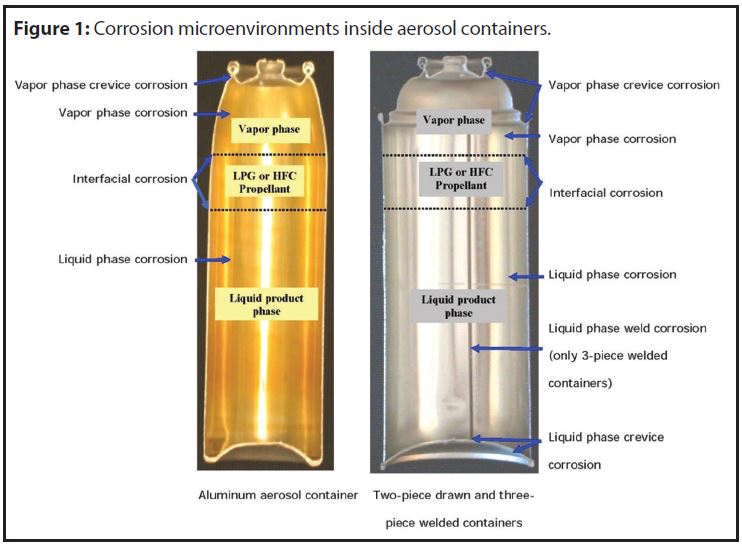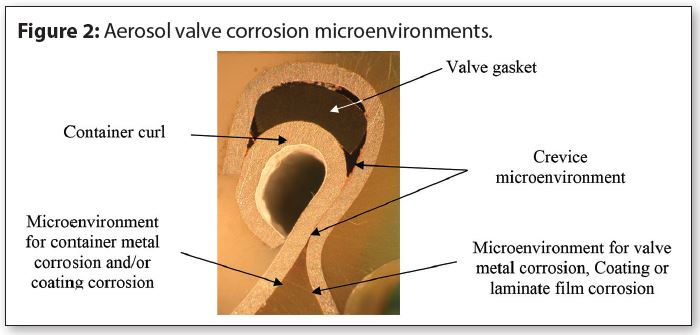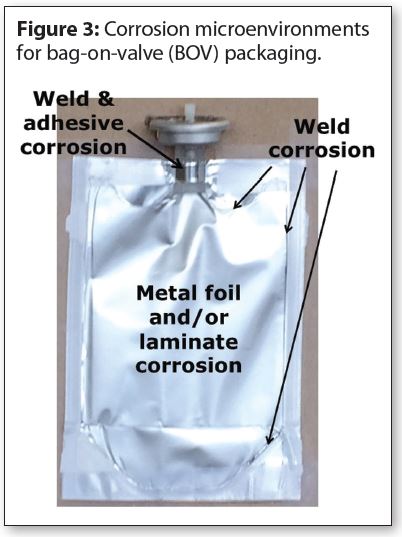Written on: January 1, 2022 by W. Stephen Tait
Happy New Year, everyone. In the December 2021 issue of SPRAY, I discussed the most common formula factors that affect spray package corrosion. In this issue, we’ll complete the discussion with the most common package factors that affect spray package corrosion:
1. Type of package (e.g., aerosol containers and bag-on-valve)
2. Type of internal package surface treatment (e.g., packages with or without internal coatings or polymer films)
3. Microenvironments inside a package
1) Type of package
Currently, spray packaging consists of traditional aerosol containers and aerosol containers with internal bags. No single type of spray package is more corrosion-resistant than another. In other words, there’s no type of spray package that will resist corrosion by all types of formulas.
Internal bags are typically either blow molded bags or laminate metal foils formed into bags. Laminated foil bags are attached to aerosol valves.
Traditional aerosol containers are currently fabricated from either steel or aluminum alloys.
2) Package surface treatment
The treatment of spray package internal surfaces includes very thin tin metal coatings, microscopic coatings of chromium and various polymer coatings on steel containers. Aluminum container internal surfaces are coated with thin polymer coatings. Laminate films for internal bags are aluminum foil with a laminated film bonded to the foil. Laminate films can be either a single layer or a bi-layer of two different polymers. Both steel and aluminum aerosol valves are coated with a variety of polymer coatings or polymer laminate films.
3) Corrosion microenvironments
Figure 1 provides a photograph that identifies the various corrosion microenvironments inside aluminum (left) and steel (right) aerosol containers. The steel container in Figure 1 is constructed by seaming the top and the bottom to the body. However, steel aerosol containers today also include those constructed by seaming either only the top or only the bottom to the body.

Simultaneous corrosion in more than one microenvironment does occur. In most situations, there is also a high probability of corrosion in more than one microenvironment. A phenomenon known as chasing corrosion around the container occurs when a corrosion inhibitor stops corrosion in a specific microenvironment and subsequently starts in another microenvironment. Figure 2 provides a photograph that illustrates the various corrosion microenvironments for aerosol valves crimped (clenched) to the top curl of an aerosol container. The gasket above the curl seals the container to the aerosol valve. A cut gasket is shown in
Figure 2, but other types of gaskets are also used to seal valves to containers.

Notice in Figure 2 that a corrosion microenvironment is formed in the crimp crevice between the valve and the container curl. The cavity formed between the crimp and the gasket is also a macroenvironment. Other microenvironments occur in the area below the curl-valve crimp in Figure 3 whenever there is metal and/or coating/laminate film corrosion.

Figure 3 provides a photograph of the various corrosion microenvironments inside bag-on-valve (BOV) packages that are inserted inside aerosol containers. Microenvironments form when either the laminate film or the metal foil corrodes.
Summary
The more common formula factors and package factors that cause or contribute to spray package corrosion were identified in Part 1 and Part 2 of this column. Synergy between these two factors adds to the complexity of spray package corrosion. This complexity explains why spray package corrosion is typically difficult to predict. Consequently, corrosion testing is needed to determine if a given formula with specific ingredients will either cause or contribute to spray package components.
Thanks for your interest and I’ll see you in February. Contact me at 608-831-2076; rustdr@pairodocspro.com; or from one of our two websites pairodocspro.com
and aristartec.com. SPRAY